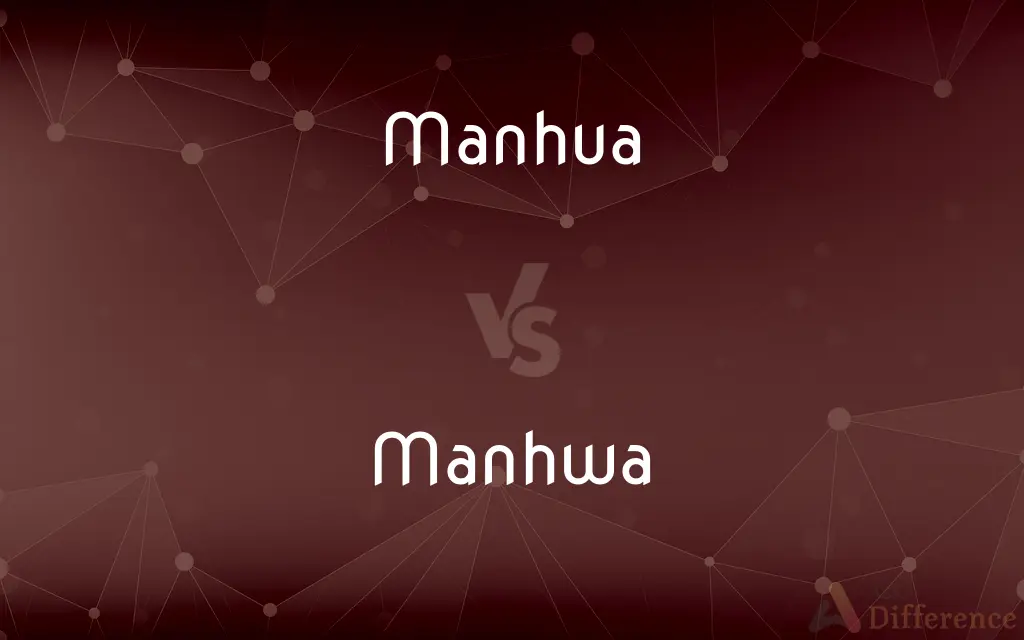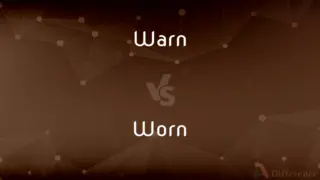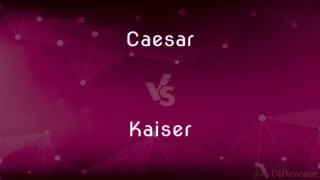Manhua vs. Manhwa — What's the Difference?
By Tayyaba Rehman & Fiza Rafique — Updated on April 2, 2024
Manhua are Chinese comics, while Manhwa are Korean comics, each reflecting their country's culture and storytelling style.

Difference Between Manhua and Manhwa
Table of Contents
ADVERTISEMENT
Key Differences
Manhua refers to Chinese comics and graphic novels, originating from China and often featuring a distinctive Chinese cultural and artistic style. These comics can be read from left to right, traditional top to bottom, or in other formats, depending on the artist's preference. Manhwa, on the other hand, are Korean comics and graphic novels that have grown in popularity worldwide. Originating from South Korea, manhwa is typically read from left to right, aligning with Western reading habits.
The content and themes of manhua often draw heavily on Chinese history, folklore, and mythology, offering a rich tapestry of stories that range from historical dramas to martial arts epics. Manhwa, while also diverse in its themes, frequently incorporates elements of Korean culture, history, and modern life, making it a vibrant part of Korean entertainment alongside K-dramas and K-pop.
Both manhua and manhwa have expanded beyond their traditional formats to digital platforms, with manhua being available on various Chinese webcomic sites and manhwa on Korean webtoon platforms. This digital evolution has made them accessible to a global audience, increasing their popularity and influence.
While both forms of comics are part of the broader Asian comic tradition, which also includes Japanese manga, they each possess unique characteristics in terms of art style, storytelling, and cultural references. This distinction is not only a reflection of their different origins but also of the diverse cultural narratives they aim to tell.
Understanding the difference between manhua and manhwa is essential for appreciating the cultural and artistic diversity within the world of Asian comics. Each offers a unique window into the lives, histories, and imaginations of their respective countries, enriching the global comic landscape.
ADVERTISEMENT
Comparison Chart
Origin
China
South Korea
Language
Chinese
Korean
Reading Direction
Varies (left to right, top to bottom, etc.)
Left to right
Themes
Chinese history, folklore, mythology
Korean culture, history, modern life
Format
Print and digital
Print and digital
Popularity
Popular in China, with growing global reach
Widely popular in Korea and internationally
Cultural Influence
Reflects Chinese cultural styles and values
Reflects Korean cultural styles and values
Compare with Definitions
Manhua
Can be read in multiple directions, traditional and modern.
This manhua reads from top to bottom, embracing traditional Chinese text orientation.
Manhwa
Graphic novels and comics that come from South Korea.
The manhwa explored themes of family and identity against the backdrop of modern Seoul.
Manhua
Often explores Chinese history and folklore.
The series is a manhua that delves into the complexities of the Three Kingdoms period.
Manhwa
Rich with Korean cultural and historical references.
This manhwa series provides insight into traditional Korean folklore through its storytelling.
Manhua
Illustrated stories originating from China.
The manhua depicted tales from ancient Chinese mythology, bringing legends to life.
Manhwa
Has gained international popularity, partly due to the Hallyu wave.
The global success of this manhwa is a testament to the growing influence of Korean culture worldwide.
Manhua
Features a wide range of artistic expressions unique to Chinese culture.
The art style of this manhua combines classical Chinese painting techniques with modern comic art.
Manhwa
Aligns with Western reading habits.
Like most manhwa, this comic is read from left to right.
Manhua
Available in both physical books and online platforms.
Fans can read the latest manhua chapters on popular Chinese webcomic sites.
Manhwa
Especially popular in webtoon format, accessible on smartphones and computers.
The webtoon platform has revolutionized how people read manhwa, making it available worldwide.
Manhua
Manhua (simplified Chinese: 漫画; traditional Chinese: 漫畫; pinyin: mànhuà; lit. 'impromptu sketches') are Chinese comics produced in China and in the Greater China region.
Manhwa
Manhwa (Korean: 만화; Hanja: 漫畵; Korean pronunciation: [manhwa]) is the general Korean term for comics and print cartoons (common usage also includes animated cartoons). Outside Korea, the term usually refers to South Korean comics, although the comics industry is emerging in North Korea as well.
Manhua
(comics) Chinese comics
Manhwa
(comics) A Korean comic.
Common Curiosities
Do manhua and manhwa share themes with Japanese manga?
While there are thematic overlaps, manhua and manhwa incorporate unique cultural and historical elements from China and Korea, respectively.
How do digital platforms affect the distribution of manhua and manhwa?
Digital platforms have significantly expanded the audience for both manhua and manhwa, making them accessible to readers worldwide.
What makes manhwa reading direction align with Western habits?
The left-to-right reading direction of manhwa is similar to Western comics and books, making it easily accessible to international readers.
What is the main difference between manhua and manhwa?
Manhua are Chinese comics, reflecting Chinese culture, while manhwa are Korean comics, showcasing Korean cultural elements.
Can manhua be read in different directions?
Yes, the reading direction of manhua can vary, including left to right and top to bottom, depending on the artist's preference.
Why have manhwa become popular internationally?
The international popularity of manhwa is partly due to digital distribution through webtoons and the global interest in Korean culture.
Can I find manhua and manhwa in languages other than Chinese and Korean?
Many manhua and manhwa are translated into various languages, thanks to their growing international fanbases.
Are the art styles in manhua and manhwa different?
Yes, each has distinct art styles influenced by their respective cultures, though there is considerable diversity within each category.
Is the content of manhua and manhwa suitable for all ages?
Like all forms of media, manhua and manhwa cover a wide range of genres and themes, some of which are designed for mature audiences.
How can I start reading manhua or manhwa?
Many online platforms and apps offer a wide selection of manhua and manhwa, with some available for free or through subscription services.
Share Your Discovery

Previous Comparison
Warn vs. Worn
Next Comparison
Caesar vs. KaiserAuthor Spotlight
Written by
Tayyaba RehmanTayyaba Rehman is a distinguished writer, currently serving as a primary contributor to askdifference.com. As a researcher in semantics and etymology, Tayyaba's passion for the complexity of languages and their distinctions has found a perfect home on the platform. Tayyaba delves into the intricacies of language, distinguishing between commonly confused words and phrases, thereby providing clarity for readers worldwide.
Co-written by
Fiza RafiqueFiza Rafique is a skilled content writer at AskDifference.com, where she meticulously refines and enhances written pieces. Drawing from her vast editorial expertise, Fiza ensures clarity, accuracy, and precision in every article. Passionate about language, she continually seeks to elevate the quality of content for readers worldwide.













































